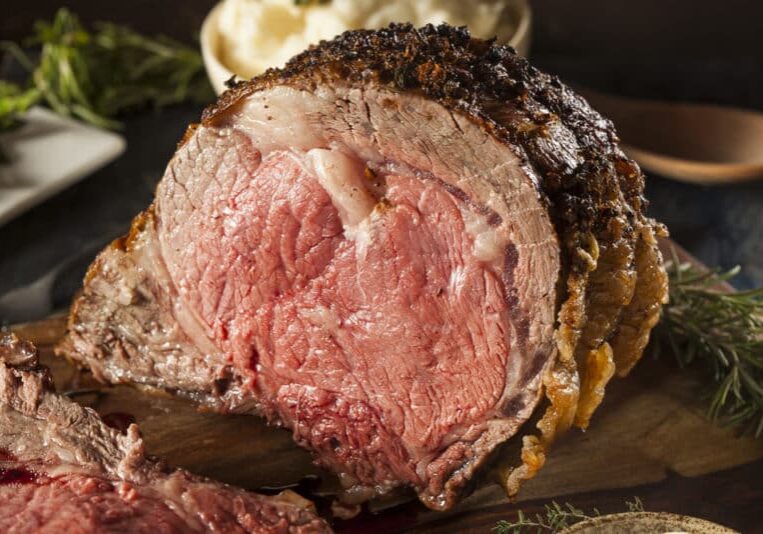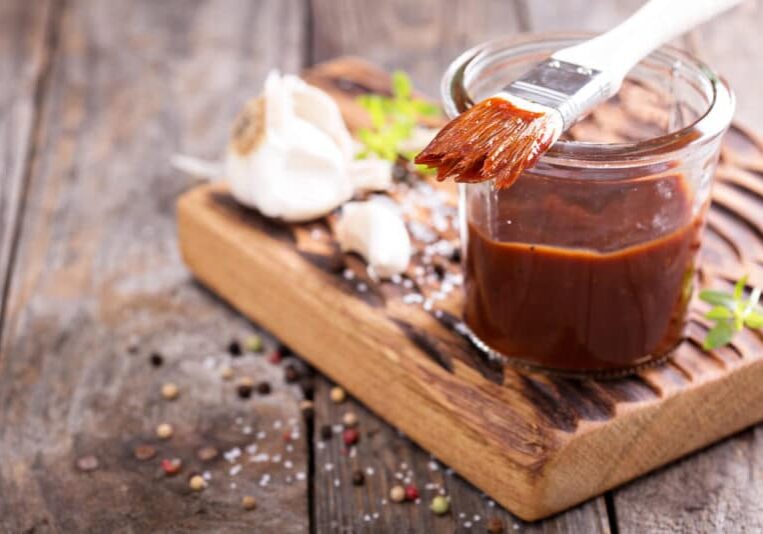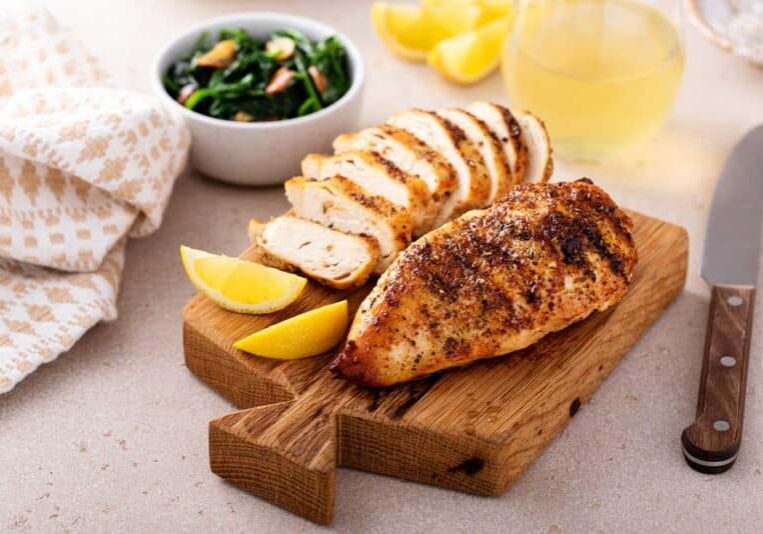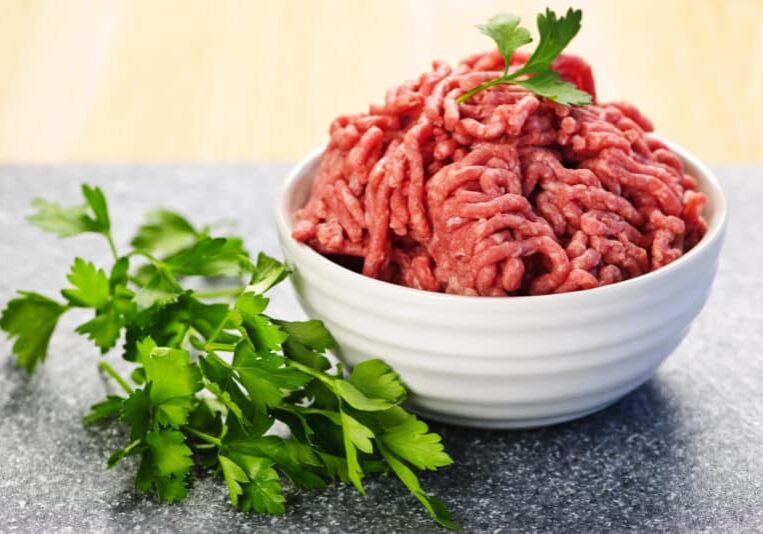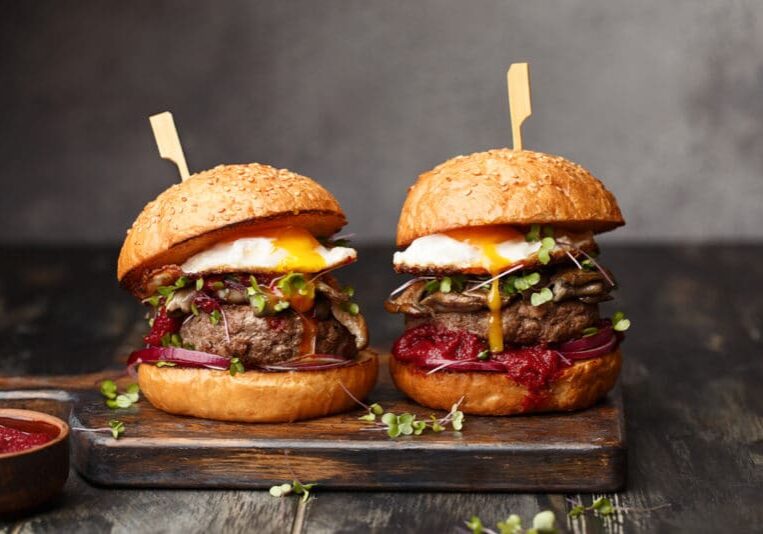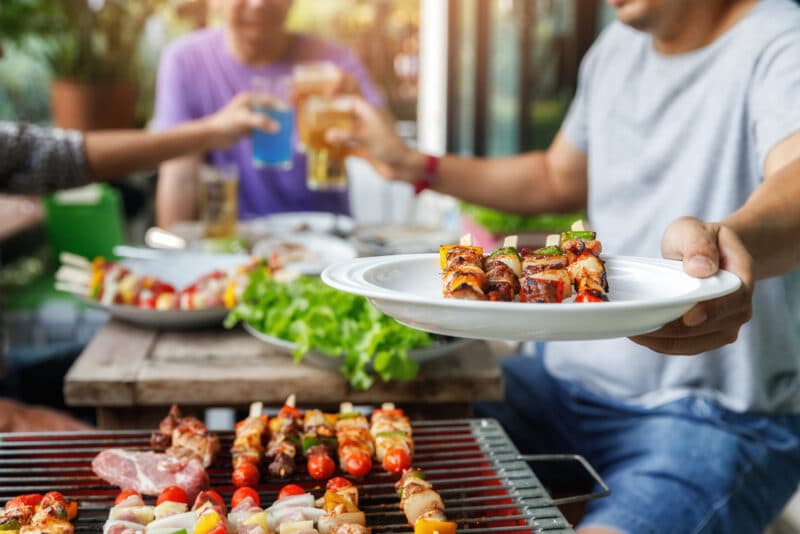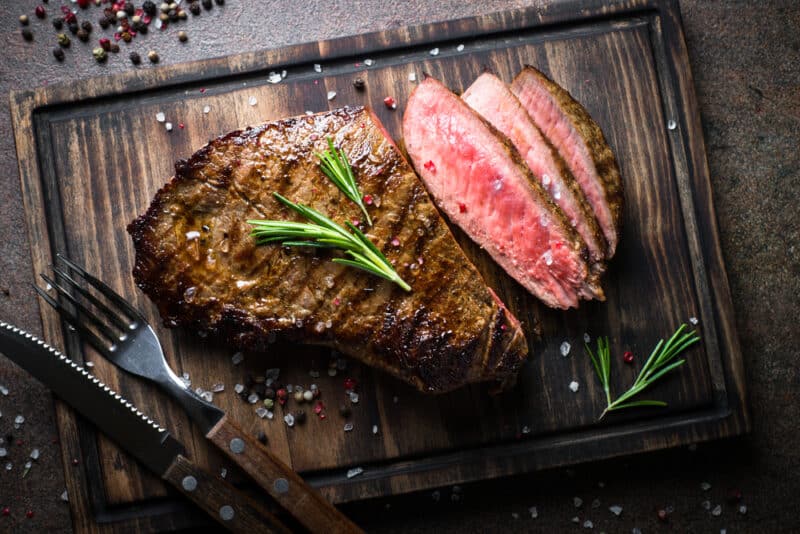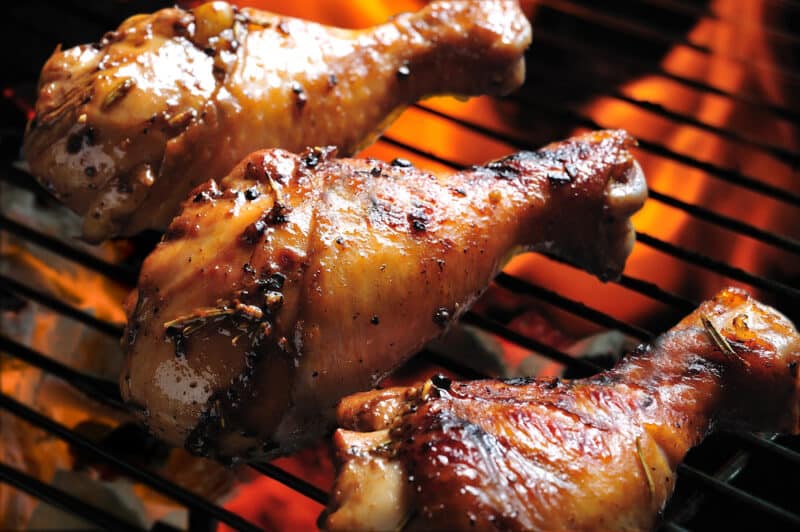Best Internal Temp for Brisket
TheGrillingMaster.com is reader-supported. If you buy something using the links on our site, we might earn an affiliate commission at no added cost to you. This helps us pay our staff to keep making awesome content for you!
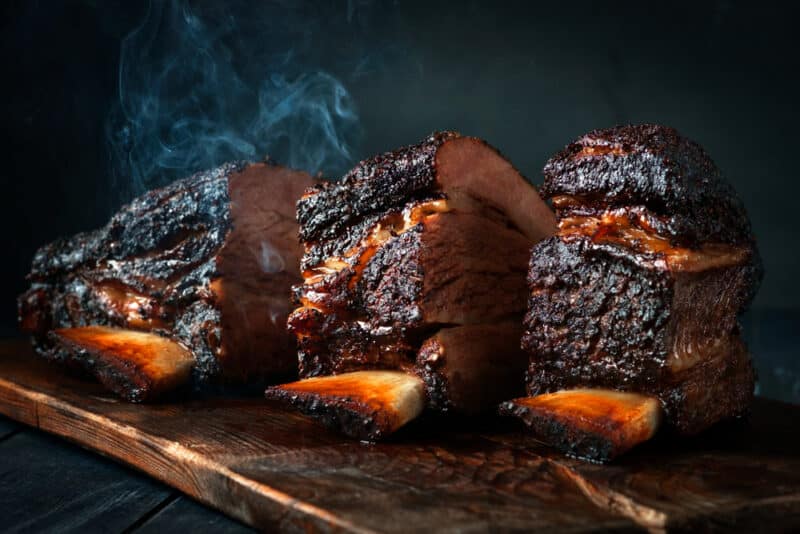
The best internal temperature for brisket is 195°F. Remember that the internal temp can increase up to 10 degrees even after it has been removed from the grill.
Many people love the traditional dish of smoked brisket, but for the ultimate completed product, you need to know what the appropriate internal temperature is.
Your smoked brisket will be more flavorful and tender if you know what temperature to shoot for.
This post will discuss the ideal internal temperature for smoked brisket as well as other helpful hints and techniques.
1. What is the Best Internal Temp for Brisket?
Since cooking times can vary depending on the size and thickness of the brisket, using a meat thermometer is the most reliable way to determine when it’s finished.
The ideal internal temperature for tender and juicy brisket is 203°F, but because the temp continues to rise when you rest the meat before serving, it’s best to remove it from the grill at about 195°F.
Maintaining the Internal Temperature
Keeping the temperature constant while smoking brisket is important for a tender and flavorful outcome. After smoking the brisket for a few hours, wrap it in foil to prevent it from drying out.
Can You Overcook a Brisket in a Smoker?
Yes, it’s possible to overcook smoked brisket. Dry, tough, and flavorless meat can result from overcooking. Keep an eye on the temperature regularly to prevent overcooking.
2. How to Tell if Your Brisket is Done
There may be times when your brisket seems done before the internal temperature reaches 195°F. When that happens, you can use one of the following three ways to test whether the brisket is cooked:
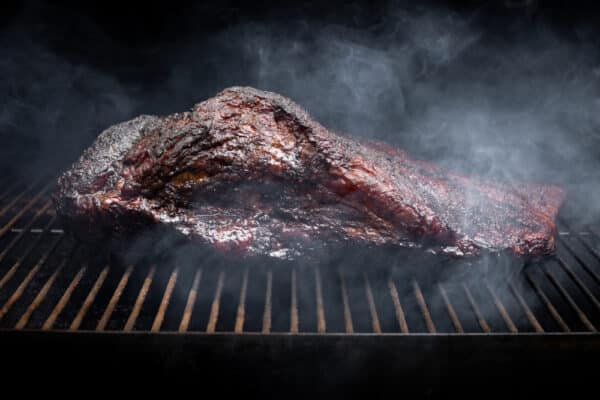
Related Reading: How long does prime rib last?
1. Probe Test
- In the probe test, a knife or toothpick is used to confirm if the brisket is cooked through the middle.
- If the probe slides in and out without resistance, as easily as it would through butter, the meat should be done.
- This method has one major disadvantage: too many tests will dilute the meat’s flavor due to the fact that probes allow heat and juices to escape.
2. Poke Test
- The poke test follows the same principle.
- You can test the resistance by inserting a fork into the meat and twisting it.
- You know the brisket is ready when it twists easily without much resistance.
3. Tug Test
- A tug test is done with a thin slice of the brisket.
- Using both hands, hold the left and right ends of the slice of brisket.
- The brisket is done cooking if the meat tears immediately.
3. Tips for Smoking Brisket
It is essential to keep an eye on the internal temp of your brisket; however, there are other elements that will help you become THE grilling master.
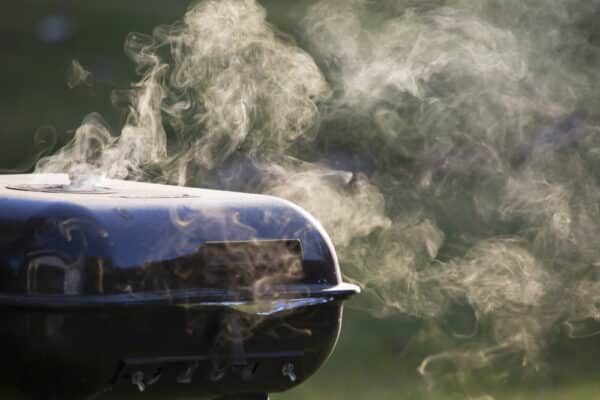
-
Patience is Key
The first thing is to understand that even the best beef brisket is a tough cut of meat.
Therefore, slow cooking is vital to end up with a tender, juicy, and flavorful home-cooked brisket.
Be prepared to tend to your masterpiece for about 1.5 hours per pound – up to 12 hours for an 8-pound brisket.
-
Place Thermometers Correctly to Measure the Internal Temp
Again, the internal temp of your brisket is what pulls it all together, making the correct placement of the thermometer crucial.
You want to insert the thermometer in the thickest part of the meat, which cooks at a slower pace than the thin parts.
Inserting it from the side of the brisket cut is better than from the top.
Your grill or smoker might have two temp probes, allowing you to monitor the temperature for the thick and thin parts of the meat.
-
Keep your Cooker Humid
To keep the inside of the smoker moist, place a pan of water beneath the cooking grate.
This will help make the evaporation, collagen breakdown, and fat-rendering processes happen at the same rate.
A humid environment will also help maintain the natural tackiness of the brisket’s surface, which can increase smoke penetration.
Try using a charcoal smoker for more flavor.
-
Practice Makes Perfect
You might not get the brisket’s flavor, texture, and doneness perfect the first time, or even the second and third times, but don’t despair!
As a beginner grill master, there’s still a lot to learn when attempting to make the best brisket for your friends and your family.
Issues to consider include the size and the cut of the brisket, and the smoker you’re using.
This is a difficult cut of beef to cook, but remember repetition builds perfection.
Related Reading: Use a Spritz to add flavor
4. What Happens if Brisket is Undercooked?
Although beef is safe to eat when cooked at temperatures below 210°F, the connective tissue in the brisket will not have softened up enough.
If you try to serve undercooked brisket, it will be difficult to chew and will not be very enjoyable.
Therefore, we suggest that you do not attempt to undercook a brisket.
5. What Happens if You Overcook Brisket?
Overcooked brisket is as unappetizing as undercooked brisket.
Although it will fall apart easily, it will likely be dry and unpleasant to eat.
Again, pull your smoked brisket off the grill when it reaches about 195°F
Let the temp rise to the final temperature of about 205°F while it rests – setting you up for waves of compliments!
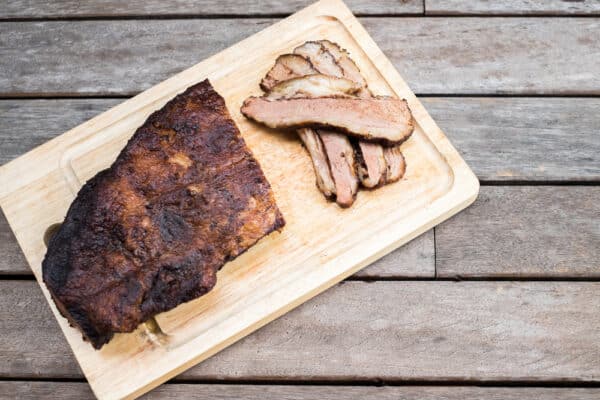
Overcooked Brisket is dry and flavorless
6. Why Do People Recommend Different Brisket Internal Temperatures?
It is a fact that every brisket and grill master has their own personal way of preparing and serving their smoked brisket.
Unless you have shared the secrets of a pit master who prepared the perfect smoked brisket, use the 195°F rule of thumb.
Your results might be perfect after the brisket’s resting period.
However, you are the master of your own griller or smoker, so you are free to experiment until you too can boast of mastering the skills of preparing the perfect smoked brisket!
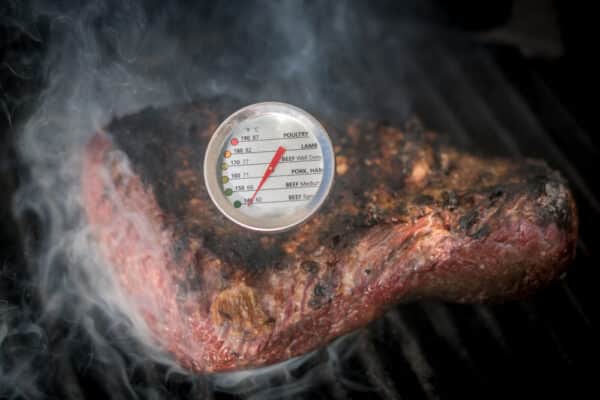
7. Why Do We Cook Brisket to a Higher Internal Temp Range?
High temperature is essential when cooking brisket to effectively break down the tough connective tissue.
A high temperature creates a flavorful, textured crust that not only helps to make the meat tender but also helps to retain moisture.
All in all, cooking brisket at a high temperature is essential to get the desired flavor and texture.
8. What is a Brisket, and Why is it So Tough?
A brisket is a cut of beef taken from the lower chest of a cow.
It is known for its toughness due to the heavily worked muscles in that area, making it dense and flavorful.
The brisket is a large cut of meat, with a full-packer typically weighing between 10–15 pounds.
The marbling of a full-packer brisket can vary, and its grains, or muscle fibers, can run in different directions.
It can be divided into two parts – the flat and the point – for easier cooking and serving.
The flat has minimal fat marbling and a fat cap on top. The low-fat content makes the flat cook through faster.
The point has more internal fat and connective tissue, needing a longer cooking process.
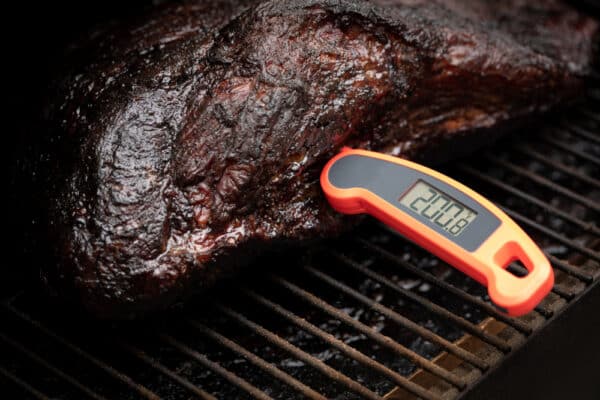
-
Why Should We Smoke Brisket to Break Down Connective Tissue?
Cooking brisket at low heat for an extended period of time can make the connective tissues of the meat softer and juicier.
The smoke will give the meat a unique flavor and the slow cooking allows the collagen in the connective tissues to turn into gelatin, providing further tenderness.
The long cooking process also allows moisture to evaporate, resulting in a more intense beef flavor and a tender and delicious end product.
-
Why Does My Brisket’s Internal Temp Stop Rising?
When you’re cooking a brisket, the temperature may stop rising between 150°F-170°F.
This is called the stall, and it happens because moisture comes out of the meat and the surface starts to dry up, which slows down the cooking.
This is normal, but it can be nerve-wracking if it’s your first time. So, be warned!
Just wait and it will start to rise again. You can also wrap your brisket in butcher’s paper or foil to help.
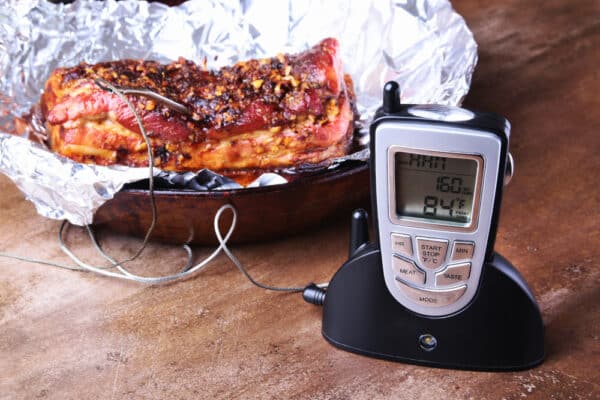
Related Reading: Measure how much prime rib you need for each person.
9. When to Pull Brisket off The Smoker
Until you have developed your own master grilling plan for smoking brisket, pull the meat off the smoker when the internal temp reaches 195°F.
If you are unsure, you can also do the probe, poke, or tug tests explained above.
Remember that the internal temp will continue rising to about 205°F even after you have pulled the brisket from the smoker.
-
How Long Will Your Brisket Take to Reach the Ideal Internal Temp?
Smoking a brisket can take a very long time.
A typical brisket weighs between 8 and 11 pounds, and it is best cooked at a low cooking temperature (225-250°F).
You need to keep an eye on it until it reaches an internal temperature of 195°F to 200°F, which usually takes 1.5 hours per pound.
An 8-lb brisket will take about 12 hours to be ready.
This slow-cooking method will make the brisket tender and juicy, and it will taste wonderful.
-
How to Wrap Brisket
You can prevent your brisket from drying out by wrapping it around halfway through the smoking process.
It is also useful if the cooking process goes faster than you expected, since the wrapping delays the further darkening of the outside of the brisket.
Take the meat out of the smoker, and close the smoker to avoid losing too much heat.
Wrap the brisket tightly in foil or a double layer of butcher’s paper.
Don’t forget to insert the meat thermometer again, pushing it through the wrapping.
Place the wrapped meat back in the smoker and reset the cooking probe alarm to 195°F.
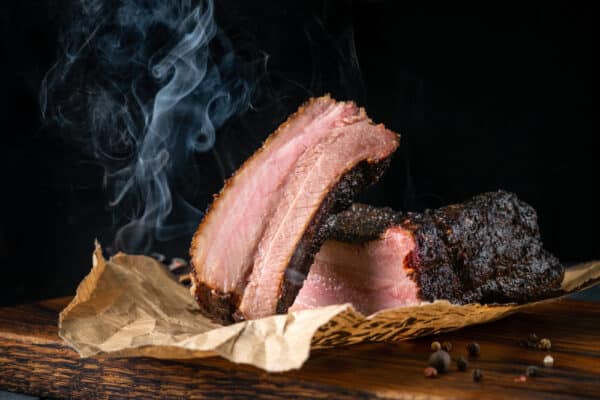
-
How to Rest Your Brisket?
It’s important to wait a while and rest the brisket after taking it out of the smoker.
Cover it loosely with a large piece of butcher’s paper or aluminum foil, so the juices can move around inside.
If you cut it too soon, the juices will run out, and it won’t be as tender and juicy.
Wait at least 30 minutes to an hour.
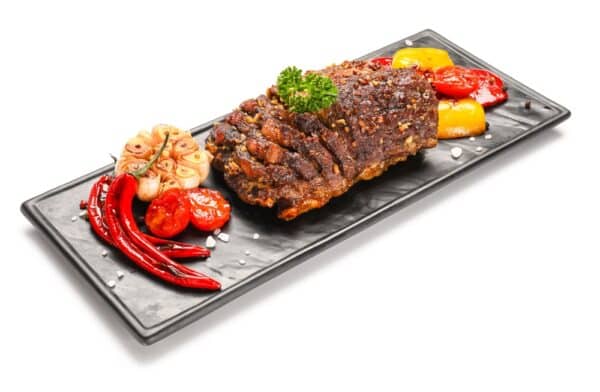
-
How to slice your brisket
After you’re done cooking your brisket, give it some time to rest, or else all the good juices will spill out when you cut it.
If you don’t plan to eat it all in one go, don’t cut it until you’re ready to eat it. This will help keep it juicy and delicious.
Taking the time to cut it right is worth it after all the work you put into smoking it.
Here’s how to slice the brisket:
- Let it rest for 30 minutes.
- Make sure you have a large butcher’s plank and a sharp knife
- Separate the brisket’s fat side and leaner side — flat and the point — parts of the brisket because their muscle fibers or grains run in different directions.
- Look for the direction of the grain in each part.
- Slice evenly against the grain for perfect slices of tender brisket.
- Serve and enjoy!
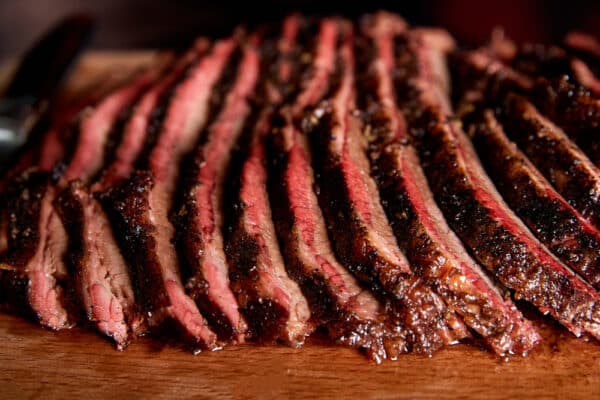
10. Finishing Brisket in Oven to Reach the Best Internal Temp
You can finish your smoked brisket in the oven, without spoiling it.
This is a great way to get the same smoky flavor but in a shorter time.
After smoking the brisket for several hours, you can wrap it in foil and finish it in the oven.
This is a good idea if the weather isn’t good outside or if you run out of time.
11. Is Smoked Brisket Healthy?
Yes, beef brisket is healthy.
According to Dr. Stephen Smith, Texas A&M AgriLife Research scientist, the brisket cut has higher levels of oleic acid than cuts like the flank or plate.
Oleic acid increases levels of high-density lipoprotein (HDL), more commonly known as “good” cholesterol.
FAQs
-
How Long to Cook Prime Rib Per Pound? (For All Types of Doneness)
For a prime rib roast, the time it takes to cook depends on how done you want it to be and how heavy it is.
Here are some rules to follow:
Put it in the oven at 500°F for 15 minutes, then turn down the heat to 350°F and keep cooking until it’s done the way you like it.
- Rare: 12–15 minutes per pound (when the internal temperature reaches 130°F)
- Medium-Rare: 15–18 minutes per pound (internal temperature of 140°F)
- Medium: 18–20 minutes per pound (internal temperature of 145°F)
- Medium-Well: 20–22 minutes per pound (internal temperature of 150°F)
- Well-Done: 22–25 minutes per pound (internal temperature of 160°F)
It’s a good idea to use a special thermometer to check how hot the meat is on the inside. Wait 10–15 minutes before cutting it, so the yummy juices can spread out.
-
How Long Will Prime Rib Last in the Refrigerator Before Cooking?
You can keep prime rib in the fridge for 3 to 5 days before cooking it.
Keep it in the original packaging or wrap it in plastic wrap, so it doesn’t dry out.
Keep it in a cold part of the fridge and make sure the temperature is under 40°F.
It’s best to cook it soon though, so it tastes and looks the best.
-
How Many Beef Ribs in a Half Rack?
Half racks of beef ribs come with 6 to 8 ribs.
Each piece is about the size of your thumb, which is a good guide if you want to know how many ribs to prepare per person.
-
How Many Briskets Per Cow?
The steer or cow has two pieces of meat called a brisket.
They come from the front part of the animal’s body and are just beneath the shoulder.
These muscles work hard and help carry the weight of the animal.
A brisket usually weighs about 10 to 12 pounds, depending on the size of the animal.
In a Nutshell
Becoming a master brisket smoker is all about the internal temperature of the meat – and patience. The best temperature for smoking a brisket is somewhere between 190- and 205 degrees Fahrenheit.
It is important to monitor the temperature of the brisket while it is in the smoker and to use a meat thermometer to make sure it is cooked properly. Smoking a brisket could be daunting, but it’s a great way to enjoy a delicious meal with friends and family. (And to become the GRILLING MASTER of the neighborhood!)
Learn More About Grilling
If you want to learn more about grilling, check out these other helpful resources!

Kevin Turner
Hi there, I'm Kevin Turner, Founder and CEO of thegrillingmaster.com. I started this website to share my passion and knowledge with you. You can leverage my years of experience as a pit master and professional to grill great food!
About The Grilling Master
Hi there, I'm Kevin Turner, Founder and CEO of thegrillingmaster.com.
My passion has always been grilling, smoking and BBQ delicious meats that satisfy my inner carnivore!
I started this website to share my passion and knowledge with you, the hungry reader who wants to prepare the perfect meal.
You can leverage my years of experience as a pit master and professional.
Send me a message and let's connect on Twitter here.


